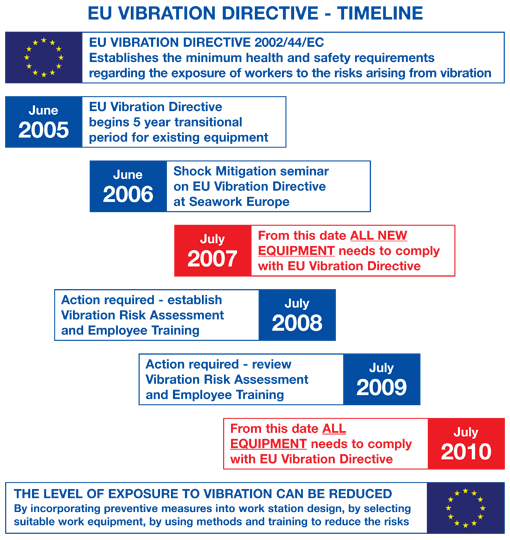EU Legislation into Whole Body VibrationWith the EU’s continued measures to encourage improvements in the safety and health of workers at work, it was considered necessary to legislate on the specific problem of exposure to mechanical vibration. Vibration poses a potential risk to workers as it may give rise to musculoskeletal, neurological and vascular disorders.
Directive 2002/44/EC applies without prejudice to more stringent and/or specific provisions contained in the Framework Directive. The Directive lays down exposure limit values and exposure "action" values (above which employers must take measures). For whole-body vibration, (WBV) the daily exposure limit value standardised to an eight-hour reference period shall be 1.15 m/s2 and the daily exposure action value standardised to an eight-hour reference period shall be 0.5 m/s2. What this means to youMonitoring and controlling an employee's exposure to vibration is now a requirement of all employers. This is not to prevent an employee from performing their duties, but instead it is to ensure that their long term health is monitored, enabling them to keep doing their job.
Vibration exposure is quantified by measuring the vibration loads experienced over a period of time (normally a working shift) and then averaging them against a reference time period. This provides a scale of how much vibration load the operator has been subjected to. The EU Directive specifies acceptable levels of exposure over an 8 hour period. One operator subjected to high levels of vibration for a short amount of time could have the same exposure level as one who is exposed to lower vibration levels, but over a greater period of time. Whilst the large shocks are easy for the operator to feel, the legislation calls for the complete exposure to vibration to be assessed. This is the total amount of energy exposed to the operator through vibration of all frequencies and amplitudes. |
View or download more information below
EC Vibration Directive 2002/44/EC effective 6th July 2010
| ||||||||||||||||||||||||||||||||||||||


